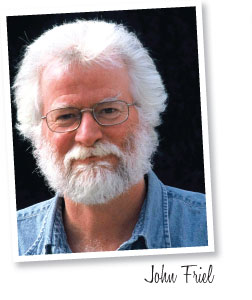3/1/2018
Columnist-Bot
John Friel

When I was new to this business, we had a customer who called his greenhouses The Plant Factory. We found it amusing; it was quite a stretch of the imagination to picture plants being “manufactured” in a “factory,” like widgets cranked out on an assembly line.
See, I’d worked in factories. The machinery was impressive: Insanely fast, brilliantly engineered, accurate, productive, and, for a gearhead, exciting ... for about a day. When that faded, insight arrived: Every human on that shop floor, catering to those machines’ needs—feeding in raw materials, bearing off finished product, lubricating, calibrating—was there simply because the machine that could perform our tasks as capably or more cheaply hadn’t yet been invented.
Automation stacks up well beside our fussy, fragile species. Machines don’t take vacations or maternity leave. They sometimes break down, but they don’t take bathroom, lunch or smoke breaks. They won’t leave you for a competitor or become competitors themselves, using what you taught them.
I fled factory work into horticulture. The machines followed. We’ve all gotten used to most of them, those that fill trays and pots, sow seeds, transplant plugs. Anyone who’s been in this, or any, business (think farming) for a while can say, “We used to do ____ by hand. Hard to believe now.”
But some jobs seemed immune, destined to remain forever something that demands a human touch, that only deft, trained hands and eyes can do. Sticking cuttings always struck me as such a task.
Several years ago in Germany, I watched a prototype robot gently grasp an individual cutting, rotate it and insert the correct end into a pot. It was pretty slow, very expensive, not 100% accurate—and eye-opening. That machine’s descendants—faster, greatly refined, still costly—have arrived in large U.S. greenhouses, taking their place in assembly lines that crank out plants like widgets. “Plant factory” is neither a stretch, nor amusing.
An online comic strip, Savage Chickens, features a character called Poet-Bot. As the name implies, it’s a versifying robot. Hilarious, right? Ahem. Programmers have developed poetry-generating algorithms convincing enough to fool nearly half the readers who try to guess “bot or not.”
Consider the Book of Kells, the 9th-century illuminated book of the gospels enshrined at Trinity College in Dublin. At least three scribes and four artists labored for years to create it; a computerized press could churn out thousands of copies in a matter of days.
Eliminating jobs is not always a terrible thing. Some are too dangerous, mind-numbingly dull or both to qualify as a fit use of a human being. Those Celtic scribes no doubt questioned their lot in life and probably suffered from carpal tunnel syndrome. Mark Twain dictated stories for over a year because of “writer’s cramp” and claimed to be the first author to submit a typewritten manuscript. Machinery to the rescue.
Greenhouse workers with repetitive motion injuries exacerbated by years of taking cuttings all day can empathize, even before they’re replaced by a robot that snips, sorts and sizes cuttings. I haven’t seen that machine yet, but I’d bet someone’s working on it. Perhaps it will recite poetry to the cutting-sticking robot as it hands over its harvest.
My gut tells me there will always be plants the machines can’t cope with. And creation—breeding plants or writing, not reproducing, gospels—will remain our kind’s bailiwick. Poetry-generating algorithms will remain training exercises for artificial intelligence because no machine could cost a publisher less than most poets earn. Poet-bot, sure. Poetry factory? Not likely.
But if this column were computer-generated ... how would you know? GP
John Friel is marketing manager for Emerald Coast Growers and a freelance writer.